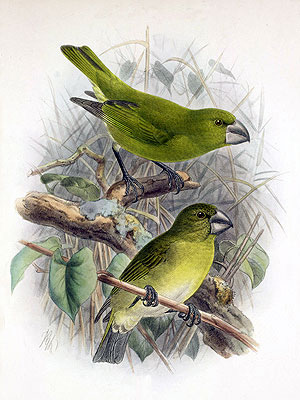Kona Grosbeak (Chloridops kona)
The Kona Grosbeak was discovered at the end of the 19th century, at that time it was restricted to a tiny, only about 10 km² large area in the north of the Kona district on the island of Hawai’i.
This rather plump and inconspicuous looking bird fed almost exclusively on the dried seeds of the Naio tree (Myoporum sandwicense (A. Gray)), and could often be located by the cracking sound of its feeding.
R. C. L. Perkins was one of the few people, that saw the bird in life, he wrote about it in the year 1893.:
“The Palila (Chloridops kona), though an interesting bird on account of its peculiar structure, is a singularly uninteresting one in its habits. It is a dull, sluggish, solitary bird, and very silent – its whole existence may be summed up in the words “to eat.” Its food consists of the seeds of the fruit of the aaka (bastard sandal-tree [Myoporum sandwicense (A. Gray)],and probably in other seasons of those of the sandal-wood tree), and as these are very minute, its whole time seems to be taken up in cracking the extremely hard shells of this fruit, for which its extraordinarily powerful beak and heavy head have been developed. I think there must have been hundreds of the small white kernels in those that I examined. The incessant cracking of the fruits when one of these birds is feeding, the noise of which can be heard for a considerable distance, renders the bird much easier to see than it otherwise would be. … I never heard it sing (once mistook the young Rhodacanthis’ song for that of Chloridops), but my boy informed me that he had heard it once, and its song was not like that of Rhodacanthis. Only once did I see it display any real activity, when a male and female were in active pursuit of one another amongst the sandal-trees. Its beak is nearly always very dirty, with a brown substance adherent to it, which must be derived from the sandal-tree.”
Note, that the name Palila is actually the Hawaiian vernacular name for another drepanidine bird species – Loxioides bailleui (Oustalet). The last living Kona Grosbeaks were seen in the year 1894.
*********************
References:
[1] R. C. L. Perkins: Notes on Collecting in Kona. The Ibis 6(5): 101-111. 1893
[2] D. Luther: Die ausgestorbenen Vögel der Welt. Westarp Wissenschaften 1986
[3] H. D. Pratt; P. L. Bruner; D. G. Berrett: A Field Guide to the Birds of Hawaii and the Tropical Pacific. Princeton University Press 1987
[4] E. Fuller: Extinct Birds. Penguin Books (England) 1987
[5] H. D. Pratt: The Hawaiian Honeycreepers: Drepanidinae. Oxford Univ. Pr. 2005
*********************

(public domain)
*********************
edited: 25.04.2017
